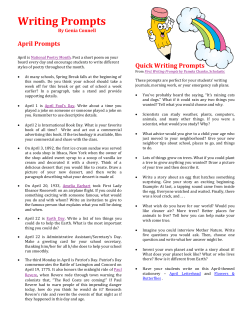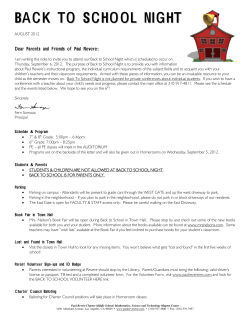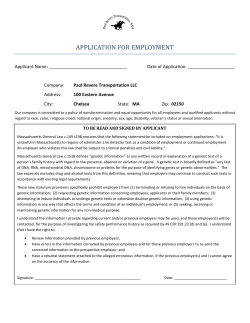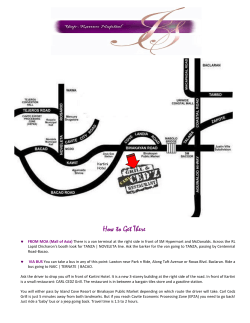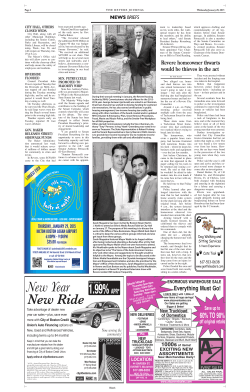
LEGEND? When does truth become Paul Revere’s Ride Before Reading
Before Reading Paul Revere’s Ride Poem by Henry Wadsworth Longfellow VIDEO TRAILER KEYWORD: HML8-136 When does truth become LEGEND? RL 4 Determine the meaning of words and phrases as they are used in a text. RL 5 Analyze how the structure of [a] text contributes to its meaning. RL 10 Read and comprehend poems. George Washington was an amazing leader, but did he really never, ever lie? When highly regarded people are famous for long enough, they sometimes become legends, and the stories about them are exaggerated. You’re about to read a poem featuring one such person. DISCUSS In a small group, come up with a list of people you consider legendary. Think about sports heroes, performers, and historical figures. What do these people have in common? Why do you think they became legends? Share your ideas with the class. 136 136-137_NA_L08PE-u01s08-brPau.indd 136 12/25/10 3:59:34 AM Meet the Author text analysis: narrative poetry You’ve read fictional stories, true stories, and stories presented dramatically. Now you’re about to read a narrative poem, which is a poem that tells a story. Like a short story, a narrative poem has the following elements: • a plot, or series of events that center on a conflict faced by a main character • a setting, the time and place(s) where the story occurs; setting is usually established in the exposition stage of the plot • character(s), or the individual or individuals who take part in the action As you read “Paul Revere’s Ride,” notice how Longfellow uses story elements to describe Paul Revere’s adventures. Review: Suspense reading skill: paraphrase Have you ever explained a complex idea using easier language, or retold a story in your own words? Restating complete information in simpler terms is called paraphrasing. A good paraphrase includes all of the main ideas and supporting details of the original source and is usually just as long, or longer. Paraphrasing challenging passages can help you better understand them. As you read “Paul Revere’s Ride,” use a chart like the one shown to paraphrase parts of the poem, such as the following lines, that may be difficult to understand: Original: Meanwhile, his friend through alley and street Wanders and watches, with eager ears . . . Paraphrase: At the same time, his friend walks through quiet streets and alleys, looking and listening carefully. Line Numbers Paraphrase Henry Wadsworth Longfellow 1807–1882 An Accomplished Teenager When he was just 14, Henry Wadsworth Longfellow was accepted into Bowdoin College in Maine. He did well in his studies and had nearly 40 poems published before he graduated. He learned French, Italian, and Spanish and translated famous literary works into English. World Fame After traveling in Europe, Longfellow returned to teach at Harvard University. He continued to write poetry that explored many important American themes. Works such as The Song of Hiawatha and Tales of a Wayside Inn, which includes “Paul Revere’s Ride,” brought American history to the attention of readers around the world. Though the death of his wife in 1861 made Longfellow deeply depressed, he remained extraordinarily kind, courteous, and generous. He never refused to give an autograph or welcome visitors who sometimes lingered around his house, hoping for a glimpse of the famous author. background to the poem By 1775, many American colonists had begun to rebel against the British government’s interference in their affairs. On the night of April 18, British troops left Boston, heading to Concord to arrest the rebel leaders and seize their weapons stockpile. Hoping to warn the rebel leaders of the British advance, Paul Revere, along with William Dawes and Dr. Samuel Prescott, set off on o make a ride that would ma Revere a legend. Author Online Go to thinkcentral.com. thinkcentral.co KEYWORD: HML8-137 Complete the activities in your Reader/Writer Notebook. 137 136-137_NA_L08PE-u01s08-brPau.indd 137 12/25/10 3:59:39 AM aul evere’s ide Henry Wadsworth Longfellow 5 10 Listen, my children, and you shall hear Of the midnight ride of Paul Revere, On the eighteenth of April, in Seventy-five; Hardly a man is now alive Who remembers that famous day and year. He said to his friend, “If the British march By land or sea from the town to-night, Hang a lantern aloft in the belfry arch Of the North Church tower as a signal light,— One if by land, and two if by sea; And I on the opposite shore will be, Ready to ride and spread the alarm Through every Middlesex1 village and farm, For the country folk to be up and to arm.” a What mood does this painting convey? a NARRATIVE POETRY According to the first two stanzas, where does the poem take place? 1. Middlesex: a county in eastern Massachusetts—the setting of the first battle of the Revolutionary War on April 19, 1775. 138 unit 1 : plot and conflict 138-142_NA_L08PE-u01s08-PaulR.indd 138 12/25/10 4:00:02 AM Illustration by Christopher Bing. 15 20 25 30 Then he said “Good-night!” and with muffled oar Silently rowed to the Charlestown shore, Just as the moon rose over the bay, Where swinging wide at her moorings2 lay The Somerset, British man-of-war;3 A phantom ship, with each mast and spar4 Across the moon like a prison bar, And a huge black hulk, that was magnified By its own reflection in the tide. b Meanwhile, his friend through alley and street Wanders and watches, with eager ears, Till in the silence around him he hears The muster of men at the barrack door, The sound of arms, and the tramp of feet, And the measured tread of the grenadiers,5 Marching down to their boats on the shore. b NARRATIVE POETRY What is the conflict being described? 2. moorings: the place where the ship is docked. 3. man-of-war: a warship, often a large sailing ship, bearing cannons and other guns. 4. spar: a pole supporting a ship’s sail. 5. grenadiers (grDnQE-dîrzP): British foot soldiers. paul revere’s ride 138-142_NA_L08PE-u01s08-PaulR.indd 139 139 12/25/10 4:00:09 AM 35 40 45 50 55 60 Then he climbed the tower of the Old North Church, By the wooden stairs, with stealthy tread,6 To the belfry chamber overhead, And startled the pigeons from their perch On the somber7 rafters, that round him made Masses and moving shapes of shade,— By the trembling ladder, steep and tall, To the highest window in the wall, Where he paused to listen and look down A moment on the roofs of the town And the moonlight flowing over all. c Beneath, in the churchyard, lay the dead, In their night encampment on the hill, Wrapped in silence so deep and still That he could hear, like a sentinel’s8 tread, The watchful night-wind, as it went Creeping along from tent to tent, And seeming to whisper, “All is well!” A moment only he feels the spell Of the place and the hour, and the secret dread Of the lonely belfry and the dead; For suddenly all his thoughts are bent On a shadowy something far away, Where the river widens to meet the bay,— A line of black that bends and floats On the rising tide like a bridge of boats. d Meanwhile, impatient to mount and ride, Booted and spurred, with a heavy stride On the opposite shore walked Paul Revere. Now he patted his horse’s side, Now he gazed at the landscape far and near, Then, impetuous,9 stamped the earth, And turned and tightened his saddle girth;10 But mostly he watched with eager search VISUAL VOCABULARY belfry n. the bell tower in a church. c PARAPHRASE Reread lines 31–41. Paraphrase this stanza, remembering to include all details in your own words. Add this to your chart. d SUSPENSE Reread lines 52–56. What words or phrases does the writer use in this passage to create a feeling of suspense? 6. stealthy tread: quiet footsteps. 7. somber: gloomy. 8. sentinel: a guard or sentry. 9. impetuous (Gm-pDchPL-Es): acting suddenly, on impulse. 10. saddle girth: the strap attaching a saddle to a horse’s body. 140 unit 1 : plot and conflict 138-142_NA_L08PE-u01s08-PaulR.indd 140 12/25/10 4:00:10 AM 65 70 75 80 85 90 95 100 The belfry tower of the Old North Church, As it rose above the graves on the hill, Lonely and spectral11 and somber and still. And lo! as he looks, on the belfry’s height A glimmer, and then a gleam of light! He springs to the saddle, the bridle he turns, But lingers and gazes, till full on his sight A second lamp in the belfry burns. e A hurry of hoofs in a village street, A shape in the moonlight, a bulk in the dark, And beneath, from the pebbles, in passing, a spark Struck out by a steed flying fearless and fleet; That was all! And yet, through the gloom and the light, The fate of a nation was riding that night; And the spark struck out by that steed, in his flight, Kindled the land into flame with its heat. He has left the village and mounted the steep, And beneath him, tranquil and broad and deep, Is the Mystic,12 meeting the ocean tides; And under the alders13 that skirt its edge, Now soft on the sand, now loud on the ledge, Is heard the tramp of his steed as he rides. f It was twelve by the village clock, When he crossed the bridge into Medford town. He heard the crowing of the cock, And the barking of the farmer’s dog, And felt the damp of the river fog, That rises after the sun goes down. It was one by the village clock, When he galloped into Lexington. He saw the gilded weathercock Swim in the moonlight as he passed, And the meeting-house windows, black and bare, Gaze at him with a spectral glare, As if they already stood aghast14 At the bloody work they would look upon. e NARRATIVE POETRY Who are the characters in this narrative poem? f PARAPHRASE Reread the lines 73–80. What’s happening in this passage? Paraphrase the passage and add it to your chart. Language Coach Personification Giving human qualities to something that is not human is called personification. In lines 97–100, the meetinghouse windows are described as being able to look at things. What does the poet expect they will see? 11. spectral: ghostly. 12. Mystic: a short river flowing into Boston Harbor. 13. alder: tree of the birch family. 14. aghast: (E-gBstP): terrified. paul revere’s ride 138-142_NA_L08PE-u01s08-PaulR.indd 141 141 12/25/10 4:00:12 AM 105 110 115 120 125 130 It was two by the village clock, When he came to the bridge in Concord town. He heard the bleating15 of the flock, And the twitter of birds among the trees, And felt the breath of the morning breeze Blowing over the meadow brown. And one was safe and asleep in his bed Who at the bridge would be first to fall, Who that day would be lying dead, Pierced by a British musket ball. You know the rest. In the books you have read How the British Regulars16 fired and fled,— How the farmers gave them ball for ball, From behind each fence and farmyard wall, Chasing the redcoats down the lane, Then crossing the fields to emerge again Under the trees at the turn of the road, And only pausing to fire and load. g So through the night rode Paul Revere; And so through the night went his cry of alarm To every Middlesex village and farm,— A cry of defiance, and not of fear, A voice in the darkness, a knock at the door, And a word that shall echo for evermore! For, borne on the night-wind of the Past, Through all our history, to the last, In the hour of darkness and peril17 and need, The people will waken and listen to hear The hurrying hoof-beats of that steed, And the midnight message of Paul Revere. g NARRATIVE POETRY What is the climax of the plot? Give reasons for your answer. 15. bleating: the cry of sheep. 16. British Regulars: members of Great Britain’s standing army. 17. peril: danger. 142 unit 1 : plot and conflict 138-142_NA_L08PE-u01s08-PaulR.indd 142 12/25/10 4:00:12 AM After Reading Comprehension 1. Recall How many lanterns were hung in the belfry of the Old North Church? What do they signify? 2. Summarize In your own words, describe what Paul Revere hoped to accomplish with his late-night ride. RL 4 Determine the meaning of words and phrases as they are used in a text. RL 5 Analyze how the structure of [a] text contributes to its meaning. RL 10 Read and comprehend poems. 3. Represent Reread lines 37–56. Draw what you think Revere’s friend sees from the bell tower. Text Analysis 4. Analyze Narrative Poetry In a chart like the one shown, note the story elements in “Paul Revere’s Ride.” Then tell the main conflict and how it is resolved. 5. Understand Paraphrasing Now that you’ve read the whole poem, review the paraphrases you wrote in your chart as you read. Did you capture the correct meaning in each case? If not, revise your paraphrases. “Paul Revere’s Ride” Setting Characters Main Plot Events • • 6. Analyze Suspense How did Longfellow create tension and excitement in the poem? Consider the way he used language, rhythm, rhyme, and repetition. Cite specific details to support your answer. 7. Evaluate Sensory Details “Paul Revere’s Ride” is full of descriptive language that appeals to the senses. List two or three images that you find most striking. Why did you choose these? Extension and Challenge 8. SOCIAL STUDIES CONNECTION Paul Revere did more in his life than ride to warn the colonists that the British army was on its way. Find out where he lived, what he did for a living, and about his involvement in the “Sons of Liberty” before and during the American Revolution. Share your findings with the class. When does truth become LEGEND? Reread lines 119–130. On the basis of this stanza, why do you think Paul Revere became an American legend? paul revere’s ride 143-143_NA_L08PE-u01s08-arPau.indd 143 143 12/25/10 4:00:51 AM
© Copyright 2025
